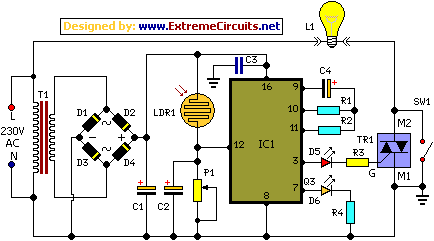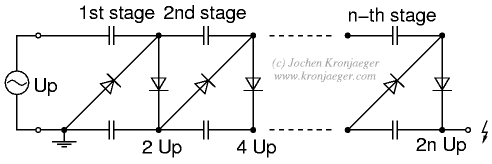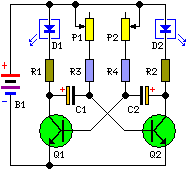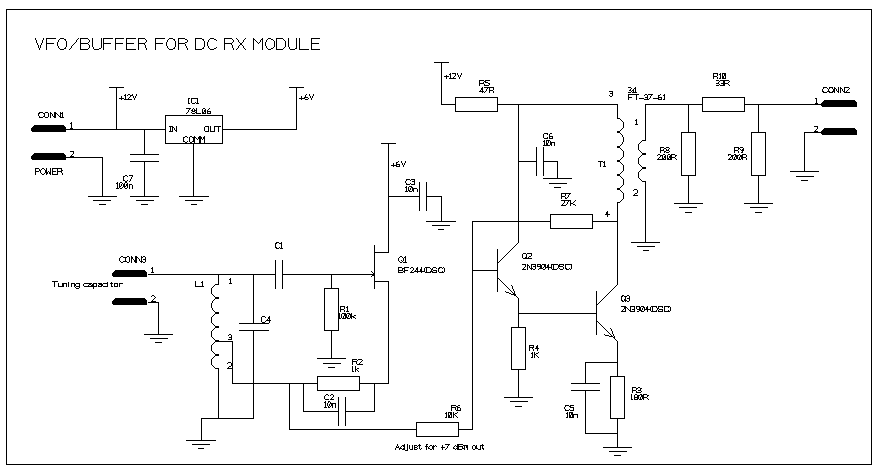
Midnight Security Light Circuit

Most thefts occur after midnight when individuals enter the second phase of sleep known as paradoxical sleep. An energy-saving circuit has been designed to deter theft attempts by illuminating potential entry points, such as the kitchen or backyard, around 1:00 AM. This circuit automatically resets in the morning and operates fully autonomously. It employs a CMOS IC, the CD4060, to achieve the required time delay. A light-dependent resistor (LDR1) manages the reset pin (pin 12) of IC1, facilitating its automatic function. During daytime, the low resistance of LDR1 keeps pin 12 of IC1 in a high state, preventing oscillation.
The energy-saving theft deterrent circuit utilizes the CD4060 CMOS IC, which serves as a timer and oscillator. The circuit's operation begins with the detection of low light levels during the night, which triggers the LDR1 to change its resistance. When the ambient light diminishes, the resistance of LDR1 increases, allowing pin 12 of the CD4060 to drop to a low state. This transition activates the oscillator within the IC, generating a square wave output that can be used to drive a relay or a transistor, which in turn powers the lights at the potential entry points.
The design includes a timing configuration that is set to turn on the lights at approximately 1:00 AM, coinciding with the period when individuals are most vulnerable to theft. The circuit can be adjusted for different timing requirements by changing the resistor and capacitor values connected to the CD4060, allowing for flexibility in operation based on user needs.
In the morning, as daylight returns, the resistance of LDR1 decreases, reverting pin 12 of the CD4060 to a high state. This reset mechanism ensures that the circuit remains inactive during the day, conserving energy and preventing unnecessary light activation. The overall design is efficient, reliable, and serves as a proactive measure to enhance home security during the hours when theft is most likely to occur.Most thefts happen after midnight hours when people enter the second phase of sleep called ˜paradoxical sleep. Here is an energy-saving circuit that causes the thieves to abort the theft attempt by lighting up the possible sites of intrusion (such as kitchen or backyard of your house) at around 1:00 am.
It automatically resets in the morning. The circuit is fully automatic and uses a CMOS IC CD 4060 to get the desired time delay. Light-dependent resistor LDR1 controls reset pin 12 of IC1 for its automatic action. During day time, the low resistance of LDR1 makes pin 12 of IC1 ˜high, so it doesn t oscillate.. 🔗 External reference
The energy-saving theft deterrent circuit utilizes the CD4060 CMOS IC, which serves as a timer and oscillator. The circuit's operation begins with the detection of low light levels during the night, which triggers the LDR1 to change its resistance. When the ambient light diminishes, the resistance of LDR1 increases, allowing pin 12 of the CD4060 to drop to a low state. This transition activates the oscillator within the IC, generating a square wave output that can be used to drive a relay or a transistor, which in turn powers the lights at the potential entry points.
The design includes a timing configuration that is set to turn on the lights at approximately 1:00 AM, coinciding with the period when individuals are most vulnerable to theft. The circuit can be adjusted for different timing requirements by changing the resistor and capacitor values connected to the CD4060, allowing for flexibility in operation based on user needs.
In the morning, as daylight returns, the resistance of LDR1 decreases, reverting pin 12 of the CD4060 to a high state. This reset mechanism ensures that the circuit remains inactive during the day, conserving energy and preventing unnecessary light activation. The overall design is efficient, reliable, and serves as a proactive measure to enhance home security during the hours when theft is most likely to occur.Most thefts happen after midnight hours when people enter the second phase of sleep called ˜paradoxical sleep. Here is an energy-saving circuit that causes the thieves to abort the theft attempt by lighting up the possible sites of intrusion (such as kitchen or backyard of your house) at around 1:00 am.
It automatically resets in the morning. The circuit is fully automatic and uses a CMOS IC CD 4060 to get the desired time delay. Light-dependent resistor LDR1 controls reset pin 12 of IC1 for its automatic action. During day time, the low resistance of LDR1 makes pin 12 of IC1 ˜high, so it doesn t oscillate.. 🔗 External reference





